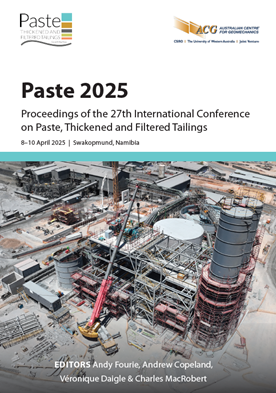Analysis of an instrumented tight-filling-induced paste containment wall failure and lessons learned for safe backfilling

|
Authors: Chatziefstratiou, V; Carmichael, P; Thompson, BD; Grabinsky, MW |
DOI https://doi.org/10.36487/ACG_repo/2555_02
Cite As:
Chatziefstratiou, V, Carmichael, P, Thompson, BD & Grabinsky, MW 2025, 'Analysis of an instrumented tight-filling-induced paste containment wall failure and lessons learned for safe backfilling', in AB Fourie, A Copeland, V Daigle & C MacRobert (eds), Paste 2025: Proceedings of the 27th International Conference on Paste, Thickened and Filtered Tailings, Australian Centre for Geomechanics, Perth, pp. 49-64, https://doi.org/10.36487/ACG_repo/2555_02
Abstract:
Tight backfilling is recognised as the major contributing factor of backfill containment wall (also termed barricade, bulkhead, fill-fence, etc.) failure, which can result in a dangerous outflow of fluid backfill. The mining industry has developed a set of operating procedures that reduce risk of such occurrences and mitigate the consequences of resultant outflows of paste. This case study from the Jabal Sayid Mine is presented, demonstrating how such procedures, and particularly a well-designed exclusion zone with catchment berm, successfully mitigated the consequences of a wall failure. The case study details how highresolution cameras quickly identified the failure and enabled an immediate halt in backfilling, limiting subsequent clean-up costs. Real-time total earth pressure monitoring is used to ensure backfilling remains within safe pressure limits. In this case, the increase in pressure past the mine’s standard 150 kPa pressure threshold was not acted on, contributing to the wall failure event. In review, better visualisation of pressure data and a ‘stop backfilling first, ask questions second’ emphasis to operators is required to improve safety. The wall failed at a measured pressure of 800 kPa, which provides important calibration of the 200 mm thick (minimum thickness at centre, flaring out to wider abutments) 20 MPa unconfined compressive strength shotcrete arched wall. High-resolution images show vertical and lateral fractures propagated in the 1–2 seconds prior to a localised failure zone (<1 m2) developing close to the rock abutment contact, allowing escape of fluid paste. It is emphasised that the wall had far exceeded design loads by this point. This event shows a useful example of where the weakest points of the asconstructed wall were. Finally, the pressure increase occurred over a ~ 1 hour period, providing useful insights into the mechanics of how tight filling induced wall failure events occur.
Keywords: backfill, inrush, tight fill, instrumentation, safe backfilling, secondary containment, containment barricade, fill-fence, bulkhead
References:
British Standards Institution 2006, EN 14488-2: 2006 Testing Sprayed Concrete - Compressive Strength of Young Sprayed Concrete, London.
Brown, R, Smith, N & Carmichael, P 2019, ‘One year of paste operations at Jabal Sayid, Saudi Arabia’, in AJC Paterson, AB Fourie & D Reid (eds), Paste 2019: Proceedings of the 22nd International Conference on Paste, Thickened and Filtered Tailings, Australian Centre for Geomechanics, Perth, pp. 387–399,
Department of Mines, Industry Regulation and Safety 2016, Underground Mine Fill Audit - Guide, Perth.
Department of Mines, Industry Regulation and Safety 2020, Significant Incident Report No. 279, Paste Wall Failure, Perth,
Gray, J 2019, Bulkhead Failure and Managing Paste Inrush Risk, presentation to Queensland Mining Industry Health and Safety Conference,
Grice, T 1998, ‘Stability of hydraulic backfill barricades’, Proceedings of the 6th International Symposium of Mining with Backfill, Australasian Institute of Mining and Metallurgy, Melbourne.
Knee, MJ 2001, ‘Safety issues associated with hydraulic backfill’, Safety Bulletin, no. 64, Department of Mineral and Petroleum Resources, Perth.
Oke, J, Thompson, BD, Bawden, WF, Lausch, P & Grabinsky MW 2018, ‘Backfill Barricade design: practical experiences and recommendations’, 52nd U.S. Rock Mechanics/Geomechanics Symposium, American Rock Mechanics Association, Alexandria.
Revell, MB & Sainsbury, DP 2007, ‘Pastefill bulkhead failures’, Proceedings of the Ninth International Symposium in Mining with Backfill, Canadian Institute of Mining, Metallurgy and Petroleum (CIM), Montréal.
Thompson, BD, Grabinsky, MW, Counter, DB & Bawden, WF 2009, ‘In-situ measurements of cemented paste backfill in long-hole stopes’, in M Diederichs & G Grasselli (eds), Proceedings of the 3rd CANUS Rock Mechanics Symposium, University of Toronto Press, Toronto.
Thompson, BD, Bawden, WF & Grabinsky, MW 2011, ‘In-situ monitoring of cemented paste backfill pressure to increase backfilling efficiency’, Canadian Institute of Mining Journal, vol. 2, no. 4, pp. 1–10.
Thompson, BD, Veenstra, RL, Carmichael, P, Bawden, WF & Grabinsky, MW 2023, ‘Best practices in continuously (or not continuously) pouring paste backfill’, in GW Wilson, NA Beier, DC Sego, AB Fourie & D Reid (eds), Paste 2023: Proceedings of the 25th International Conference on Paste, Thickened and Filtered Tailings, University of Alberta, Edmonton, and Australian Centre for Geomechanics, Perth, pp. 279–293,
Thompson, BD, Veenstra, RL, Carmichael, D, Counter, P & Grabinsky, MW 2024, ‘Lessons learned from tight or blind filling induced barricade failures’, Minefill 2024, International Symposium of Mining with Backfill, Canadian Institute of Mining, Vancouver.
Veenstra, RL, Grabinsky, MW & Thompson, BD 2024, ‘Tight filling challenges, comparing uncoupled and coupled backfilling of UG stopes with cemented paste backfill’, Proceedings of the 58th U.S. Rock Mechanics/Geomechanics Symposium, American Rock Mechanics Association, Alexandria.
Yumlu, M & Guresci, M 2007, ‘Paste backfill bulkhead monitoring — A case study from Inmet’s Cayeli mine, Turkey’, Proceedings Ninth International Symposium in Mining with Backfill, Canadian Institute of Mining, Metallurgy and Petroleum, Montréal.
© Copyright 2025, Australian Centre for Geomechanics (ACG), The University of Western Australia. All rights reserved.
View copyright/legal information
Please direct any queries or error reports to repository-acg@uwa.edu.au
View copyright/legal information
Please direct any queries or error reports to repository-acg@uwa.edu.au
